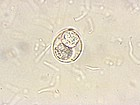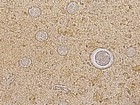Difference between revisions of "Isospora spp."
| Line 2: | Line 2: | ||
{{Taxobox | {{Taxobox | ||
| − | |name = | + | |name = Isospora spp. |
|kingdom = Protista | |kingdom = Protista | ||
|phylum = Apicomplexa | |phylum = Apicomplexa | ||
Revision as of 15:25, 28 July 2010
| This article has been peer reviewed but is awaiting expert review. If you would like to help with this, please see more information about expert reviewing. |
| Isospora spp. | |
|---|---|
| Kingdom | Protista |
| Phylum | Apicomplexa |
| Class | Coccidiasina |
| Family | Eimeriidae |
| Genus | Isospora |
| Species | There are many e.g. Isospora suis. |
There are many different species of Isospora, all of which are host specific. The most commonly seen of all the Isospora species is Isospora suis.
Identification
Each oocyst measures 20-50μm. The eggs are subspherical, and the wall is colourless and thin. When sporulated each one contains two sporocyts each with four sporozoites.
Life Cycle
There are essentially three stages in the Isospora life cycle. The first is called Sporogony and is the asexual stage of the parasite development. It occurs exogenously, and leads to the development of sporozoites in the oocysts. After this occurs, the oocysts are now deemed infective.
The host then ingests the infectious oocyst, and the digestive enzymes break down the oocyst wall, and release the infective sporozoites, which then go on to penetrate the intestinal villus epithelium, namely the jejunum and the ileum. Each sporulated oocyst contains 2 sporocysts each with 4 sporozoites. This stage will occur relatively quickly under optimal conditions of high humidity and temperatures between 20 and 40 degrees.
The next step is Schizogony. This is an asexual process which occurs endogenously. After the sporozoites invade the epithelia, they then form trophozoites. These trophozoites then form merozoites, which is known as merogony.
Gametogony, which is sexual division occurs endogenously, namely in the intestinal cells. Merozoites then form either microgamonts (male) or macrogamonts (female). Invasion of macrogametocytes containing cells by microgametocytes leads to fertilization, and the cycle continues.

